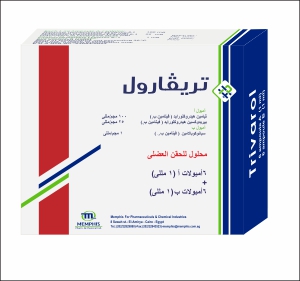TRADE NAME:Trivarol solution in Ampoule for IM injection. GENERIC NAME:Vitamin B1, Vitamin B6, Vitamin B12 COMPOSITION: Composition of Ampoule A: Each 1 ml contains: Active ingredient: Thiamine hydrochloride (Vitamin B1) 100 mg (Equivalent to Thiamine78.67mg) Pyridoxine hydrochloride (Vitamin B6 ) 25 mg (Equivalent to Pyridoxine 20.56 mg) Excipients: Sodium acid phosphate, Sodium versenate (Disodium edetate), Thiourea, water for injection. Composition of Ampoule B: Each 1 ml contains : Cyanocobalamine (Vitamin B12 ) 1 mg Excipients : Citric acid monohydrate, Dibasic sodium phosphate anhydrous, Probylparaben base, water for injection. PHARMACEUTICAL FORM:Ampoule. PHARMACOLOGICAL ACTION: PHARMACODYNAMICS: Pharmacotherapeutics group: vitamins, vitamin B1, in combination with vitamin B6 and / or vitamin B12. Trivarol contains a combination of important B vitamins, which has a particular importance as coenzymes in the intermediary metabolism of the central and peripheral nervous system. Like all vitamins, they are essential nutritional components that cannot be synthesized by the organism itself. Intake of these vitamins therapeutically complete their often incomplete nutritional intake and thus ensures the provision of the required quantities of coenzymes. The active form of vitamin B1 (thiamine) is the thiamine diphosphate. It acts as a coenzyme in carbohydrate metabolism in the decarboxylation of alpha-keto acids such as pyruvate and alpha-ketoglutarate. In the nervous tissue, thiamine is detectable in the membranes and can interfere with the biosynthesis of neurotransmitters in neuronal functions. Vitamin B6 (pyridoxine) is an important coenzyme in amino acid metabolism and, as a prosthetic group; it is a component of important enzymes in the nervous tissue. So, pyridoxine influences the biosynthesis and the concentration of many neurotransmitters such as dopamine, norepinephrine, 5-hydroxytryptamine, histamine and GABA. Pyridoxine plays an important role in both the degradation ofhomocysteine to cysteine and the re-synthesis of homocysteine to methionine. Vitamin B12 (cyanocobalamin) acts on nucleic acid synthesis and fatty acid composition in neuronal cerebrosides and phospholipids. It plays an important role as a coenzyme for the growth and replication processes in the cell, including in the homozygous to methionine resynthesis. PHARMACOKINETICS: Vitamin B1, has a dosedependent dual transport mechanism after oral taking: active resorption up to concentrations of 2μmol / l and passive diffusion above 2 μmol / l. The elimination half-Time is approximately 4 hours. The human body can store about 30 mg of thiamine. The reserve capacity is very limited with 4 to 10 days because of the rapid metabolism. Vitamin B6 Pyridoxine is absorbed rapidly and mainly in the upper gastrointestinal tract and excreted with a maximum between 2 and 5 hours. About 40 to 150 mg can be stored. The excretion in urine is 1.7 to 3.6 mg / day. Vitamin B12 Absorption from the gastrointestinal tract is by 2 mechanisms: - Release by the stomach acid and immediate binding to the, intrinsic factor ; - Regardless of "intrinsic factor" by passive influx into the blood. At doses above1.5 μg, the latter mechanism has an importance. Patients with pernicious anemia regain approximately 1% of 100 pg and above after oral taking. Vitamin B12 is mainly stored in the liver; the daily need is1 μg. The turnover rate is 2.5μg B12 / day or 0.05% of the stored amount. Vitamin B12 is mainly secreted in the bile and most of it is reabsorbed in the enterohepatic circulation. INDICATIONS: Neurological systemic diseases that are based on aseverevitamin B1, B6 and B12 deficiencywhichcannot be resolved by oral therapy. DOSAGE AND ADMINISTRATION: Dosage In severe (usually acute) cases: 1 ampoule daily until the acute symptoms are in remission. After improvement of the symptoms: 1 ampoule once to 3 times weekly. Children and adolescents:the experiences of children and adolescents are limited. Administration is therefore not recommended.
